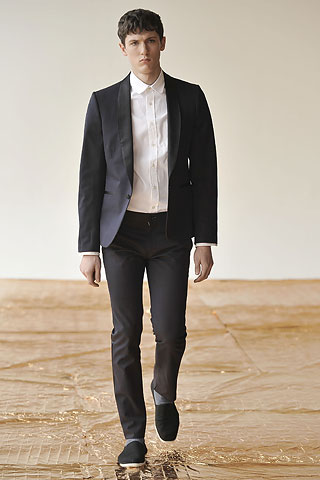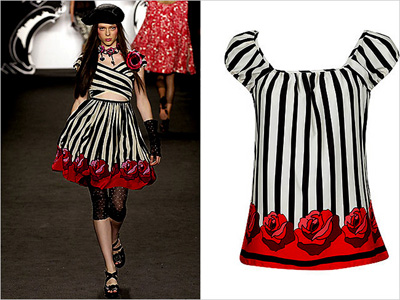Tiger Collection, Autumn/Winter 2005/2006
KD: And here you see a cardboard mountain that Taiyo and Nico made for one of his [Willhelm’s] collections.
FP: So they did work with Willhelm before. It’s great how he often collaborates with artists in his work.
KD Yes, I also think he collaborates with them in interesting ways. They try to find similarities between his work and their work and then they make something new.
KD: This is Bernhard himself. Pointing to a print from his Tiger Collection (Fall Winter 2005) depicting a photograph of a 19th century wall clock with the designer himself as a small decorative figure in black makeup and with a skirt of golden banana leaves.
FP: He is in black face…The prints seem a revisitation of colonial motives.
KD: Yes, but Bernhard also often disguises himself. Here he is supposed to be a black chief. In another collection he dressed as a 1970s porn-star. There is one picture where he is dressed like a Tyrolean guy…
KD: This print is also nice. It is a picture of all the people who worked with Bernhard at the time, all of his all staff, and they made a print of it, using the African tradition of the wet print…
Often what he does is not really explicitly political. For instance, in this next collection [Spring/Summer 2006, titled “I Am the One and Only Dominator”] there is a stars and stripes motif. Yet Bernhard would never in an interview say anything anti-American. When I asked him about it, he said: “Well everybody looks good in stars and stripes.” I like the way he is never explicit in his statement…
This [referring to the display of the Spring/Summer 2006 collection] was one of his first ideas. “I want these seventies mannequin guys with their pants down,” he asked.
FP: He was on the first cover of Butt, wasn’t he?
KD: And the model in the photos at the end of the exhibition is a very famous French porn star François Sagat.


















